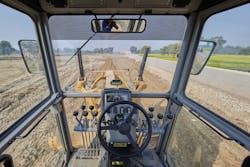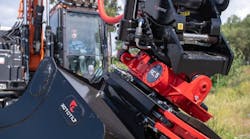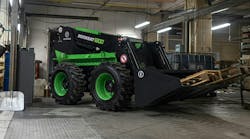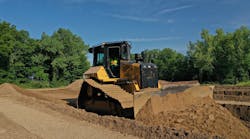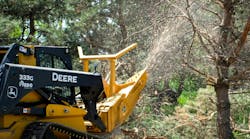Motor graders have traditionally been one of the most difficult pieces of equipment to master, but manufacturers have incorporated technology to make operation easier and increase production and efficiency.
There have been a number of key tech additions from the four major motor grader OEMs since Construction Equipment last looked at the category pre-pandemic.
See the top models of 2022.
John Deere has taken a stepped approach, adding features to existing models rather than changing model designations. The company’s GP Series, already packed with technology, has been enhanced even further.
First, Deere expanded the capabilities of its Grade Pro (GP) Series of motor graders with new technology, including Blade Stow and Auto-Gain for Cross Slope.
The features, which also include Machine Damage Avoidance, are designed to deliver higher productivity, increased uptime, and lower daily operating costs during operation.
“Our customers challenge us to find new ways to incorporate smart technologies into Deere products,” says Luke Kurth, product marketing manager, motor graders. “They are looking for solutions to help make equipment easier to run and more efficient. These new features allow new operators to come up to speed more quickly, and all operators can take full advantage of the productivity of Deere graders.”
Blade Stow and Auto-Gain are engineered to provide greater simplification for the operator. Blade Stow, standard with machine presets or Automation Suite, adds a configurable setting to automatically stow the blade with the touch of a button.
With Auto-Gain, the machine automatically adjusts the Cross Slope gain setting on the fly based on the operating conditions, eliminating the need for operators to make manual adjustments. Auto-Gain improves productivity for operators by ensuring accurate blade movement in ever-changing conditions.
The GP-Series motor graders can be further enhanced with optional Machine Damage Avoidance. When activated, the feature reduces the chance of downtime by preventing the moldboard from inadvertently contacting the tires, the cab steps, or frame, and the saddle from contacting the table.
SmartGrade motor grader models received additional enhancements for greater flexibility and productivity, including a larger file-processing capability, up to 20 percent faster file transfers, and increased real-time kinematic (RTK) radio stability, Deere says. SmartGrade machines are now compatible with network RTK and local positioning system technology.
In addition, John Deere now includes the factory-installed Premium Circle on all SmartGrade motor graders. The fully sealed bearing and pinion help reduce maintenance costs and downtime, Deere says, by eliminating wear inserts and ensuring the circle remains tight during operation, maximizing accuracy while also significantly boosting circle torque and speed.
Deere then added fully programmable Auto-Pass and Auto-Shift Plus, plus Configurable Float on GP series units as well as SmartGrade Remote Support on SmartGrade graders.
Auto-Pass programs machine movements at the beginning and end of grading passes. As it adjusts the speed of these movements and rotates the blade 180 degrees, the motor grader will simultaneously place the blade on the ground while preparing for the next pass.
Available as an option on the John Deere GP Series motor graders and standard on the John Deere SmartGrade motor graders, this feature can also be programmed to raise and rotate the blade at the end of a grading pass, mirroring the finished angle.
Auto-Shift Plus removes the need for using the inching pedal. This enables the operator to use the throttle and brake, offering increased control of the machine. Auto-Shift Plus allows for the machine to come to a complete stop without stalling.
All GP Series graders have Configurable Float, which allows float switches to be programmed to control any auxiliary function, allowing programming of up to three float switches through the monitor.
SmartGrade Remote Support connects the dealer to the SmartGrade motor grader. The dealer can troubleshoot machine issues and update grade control software from the dealership, reducing downtime. Fleets can use SmartGrade Remote Support for the remote transfer of project files. Additionally, any machine issues can be addressed from a remote location.
Caterpillar has added mastless grade control to its motor graders.
Cat Grade with 3D for motor graders is designed to improve grading efficiency, accuracy, and productivity of automated grading systems without the limitations associated with GPS masts.
The integrated mastless grade system can be installed and calibrated at the factory on new machines, or as a field retrofit for existing models. Retrofit kits are available for pre- and post-2019 M Series models equipped with or without the Attachment Ready option.
Previous GPS systems for motor graders required 6-foot-tall masts mounted to the ends of the moldboard, Cat says, exposing the components to potential damage and theft. The antennas/receivers were often removed and installed daily, limiting the machine’s time in the dirt, and the masts limited the blade’s range of motion.
The masts also limited the types of applications for the motor grader. An E-Fence feature on factory installations of Cat Grade with 3D is designed to prevent the moldboard from contacting the tires or ladder, and to prevent the circle from potentially damaging the link bar.
Cat 140, 150, and 160 motor graders were the first models equipped with the new mastless Cat Grade with 3D.
The two grader models from Case Construction Equipment are the 836C and the 856C.
The moldboard is designed to pitch, tilt, and move laterally, and can be expanded with available horizontal and bilateral extensions which further expand material retention for super-fine grading applications. A hydraulically controlled five-position saddle allows operation at over 90 degrees.
Case says its motor graders feature one of the most intelligent high-precision, load-sensing hydraulic circuits available on the market. A direct-activated axial piston pump delivers only the required amount of hydraulic pressure where it is needed.
Komatsu’s 218-horsepower GD655-7 offers cab enhancements not available on the Dash 6 model. Operating weight is slightly higher, at 38,140 pounds, and it carries the same 14-foot blade.
The steering wheel is slightly smaller to provide more visibility and operator room. A steering lever allows the operator to make small steering adjustments without needing to turn the steering wheel. Multiposition adjustable arm rests and a high-capacity air-suspension seat provide more operator comfort. An operator-presence monitoring system alerts the operator if they leave the seat without properly locking out controls.
“The GD655-7 provides operators with an all new, ergonomic working environment and the new spacious cab allows more room for operators working long days” says Bruce Boebel, senior product manager, wheeled products, Komatsu America. “Operators will appreciate the new low-effort equipment and steering levers, new transmission controls and articulation stop-at-center feature. Collectively, they significantly reduce operator fatigue.”
The 2-mode, 3-stage Variable Horsepower Control allows the selection of the appropriate mode, economy or power, to match operating parameters to application requirements for optimal fuel savings.
Komatsu Diesel Particulate Filter (KDPF) and other aftertreatment components are designed in conjunction with the engine for efficiency and long life, the company says. More than 98 percent of KDPF regeneration is performed passively, with no action required of the operator and no interference with machine operation.
The Dash 7 model also has a transmission shift lever with finger-operated forward-neutral-reverse switch meant to simplify operation and reduce required hand movement.
Komatsu’s power shift transmission, designed and built specifically for Komatsu graders, provides on-the-go, full power shifting, as well as inching capability and automatic shifting in the higher ranges.
According to the company, the industry-exclusive, dual-mode transmission (8 forward, 4 reverse) allows operators to benefit from the high travel speeds and reduced fuel consumption of a direct drive, as well as the increased tractive effort and control of a torque converter.
